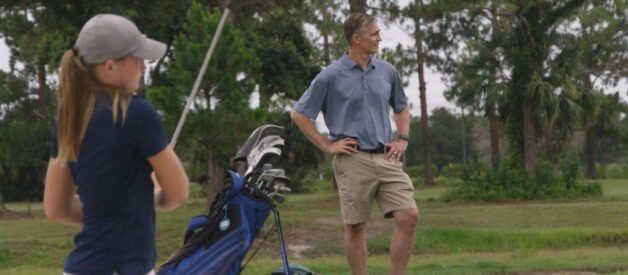(BPT) – It was a Sunday evening when Steve Ryan and his then 15-year-old daughter Kaitlin decided to head to the golf course to practice their short game. Steve felt worn out – something he could attribute to the heat or a busy week. However, things quickly took a turn as one moment he was watching his daughter take practice swings, and the next he was waking up from a medically induced coma three days later.
According to the American Heart Association, nine out of 10 individuals who experience sudden cardiac arrest (SCA) outside of a hospital will not survive. Luckily for Steve, 51, who experienced SCA that fateful evening, it was a different story thanks to immediate CPR performed by his daughter, shocks from an automated external defibrillator (AED) by paramedics, and a quick transfer to the hospital.
SCA happens when the heart suddenly stops beating, leading to a lack of blood flow to the body, and is caused by a disturbance in the heart’s electrical system. This life-threatening event is the third-leading cause of death in the U.S., with 1,000 people each day experiencing SCA outside of a hospital setting.[1]
In fact, cardiac arrest claims more lives globally than colorectal cancer, breast cancer, prostate cancer, influenza, pneumonia, auto accidents, HIV, firearms, and house fires combined.[1]
Know Your Risk
While SCA affects people of all ages, it is most common in adults and occurs twice as often in men as it does in women.
Risk factors include prior heart attack or SCA, family history of SCA or other heart disease, heart failure, low ejection fraction (a measure of the heart’s pumping ability), or fast or abnormal heart rhythms starting in the lower chambers of the heart.
Know the Signs & Differences
SCA can sometimes be confused with a heart attack – that’s why knowing the signs and differences are important. After all, for both conditions, seconds count for survival.
A heart attack occurs when blood flow to part of the heart is blocked – essentially a plumbing problem. Signs of a heart attack include chest pain or discomfort, feeling weak, lightheadedness, discomfort in the jaw, neck or back, pain in one or both arms, shortness of breath, unexplained nausea and more. It is vital to seek treatment as soon as possible to help reduce damage to the heart muscle.
SCA occurs when the heart suddenly and unexpectedly stops beating. Risk factors include abnormally fast heart rate, fluttering or pounding heart palpitations, chest discomfort, fainting and shortness of breath. An individual in cardiac arrest will lose consciousness and have no pulse. For every minute that goes by without treatment, the chance of survival drops rapidly. But survival rates can double or even triple if more people recognize the signs of SCA and know how to respond.
For individuals experiencing SCA, starting hands-only CPR immediately helps restore the flow of oxygen-rich blood to the brain and other vital organs. CPR can provide life-saving support until more-advanced emergency care is available – which is how Steve’s daughter ultimately saved his life while they waited for the paramedics to arrive with an AED.
While there are important differences between a heart attack and SCA, rapid response time for both is key. Symptoms of a heart attack may come on slowly within hours or even weeks, but SCA can happen quickly and with little to no warning. For both conditions, the time from symptom onset to response is critical. Knowing the signs and acting quickly ultimately increases the chance of survival.
Understand SCA Treatment Options
Once stabilized and initially recovered, Steve was eager to find a treatment option that would allow him to get back to his daily activities, including time on the putting green. When his doctor told him he was a candidate for an implantable cardiac defibrillator (ICD), which monitors for and treats abnormal heart rhythms, Steve decided it would help put his mind – and his family’s – at ease.
ICDs are small battery-powered devices placed in the chest for long-term treatment of abnormal rhythms and prevention of SCA. They send either high-energy shocks or low-energy, painless pacing pulses to disrupt a dangerously fast heart rhythm.
‘I feel fantastic, almost as if I never had my SCA episode. But then I touch my chest, and there is my reminder that it did happen,’ said Steve. ‘Knowing that I have a Medtronic ICD eases my worries and encourages me to continue to be active and live life to the fullest.’
Spread the Word and Act Fast
Steve remains grateful for his daughter and the medical team that saved his life, and now wants to share his story to help others. While SCA happens with little to no warning, Steve’s experience serves as a reminder of the importance of performing early hands-only CPR and how ICDs can help survivors and those at risk for SCA continue to live their lives.
This October is Sudden Cardiac Arrest Awareness Month. If you or a loved one has a fast or irregular heartbeat or other risk factors like prior heart attack, family history of SCA, heart failure, or other cardiac conditions, contact your doctor.
And if you witness someone experiencing SCA, quick response is critical to survival: contact 911, locate an AED and use it, and administer hands-only CPR until first responders arrive.
Treatment with Medtronic ICDs are prescribed by your physician, who will discuss potential benefits and risks. Results may vary; this story represents one individual’s experience with these devices.
Learn more about heart rhythm disorders and treatments at: https://www.medtronic.com/suddencardiacarrest.
[1] American Heart Association. CPR Facts & Stats. Accessed August 2021.
